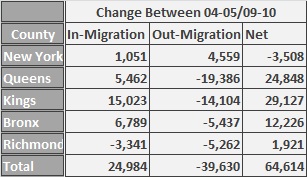The Great Recession has reshaped the face of the United States, including the New York region. Many regions of the country have completely imploded–cities such as Phoenix and Las Vegas–while others have been much more stable. Most of the talk revolves around cities like Houston and Washington D.C. when it comes to resilience, but how has the New York area held up?
Data released by the IRS shows domestic migration based on tax returns (in this case, exemptions), and it paints a very interesting picture. Included are two charts comparing the changes in domestic migration between 2004 and 2009 for New York City’s five boroughs. The results may be surprising to some, and certainly represent a complete change for New York City, which until recently had been hemorrhaging residents to other U.S. localities.
 |
| Source: IRS Migration Data |
Many have said that the Great Recession has simply reduced domestic migration in general. New York has certainly seen a decline in people leaving the city, however there has been a simultaneous uptick when it comes to in-migration as well, perhaps indicating New Yorkers are no less mobile than they were before the Great Recession. The increased volume of people moving into New York City as well as the fall in people moving out suggests that the New York region is finally becoming a draw for domestic migrants. While it remains plausible that many New Yorkers who would have moved have simply been unable to do so, given the data present, it seems much more likely that the drop-off in out-migration numbers is a result of New York’s rising appeal for everyone, not just immigrants (who have been the only source of New York’s population gains for many decades).
The shift in domestic migration has been rather drastic, but that is to be expected given how tumultuous the economy has become across much of the nation. In the span of only five years, New York saw 25,000 more people arrive than in 2004. In addition, 40,000 fewer New Yorkers debarked for the rest of the country, resulting in a relative gain of almost 65,000 people. Even though 56,000 people left New York for other parts of the country in 2009, that is a significant decline from the 120,000 that left in 2004.
Nowhere has the change in domestic migration been more pronounced than Brooklyn. Kings County posted the largest change in in-migration, at over 15,000, but the combination of increased in-migration and decreased out-migration led Brooklyn to retain almost 30,000 more residents in 2009 than in 2004, in terms of total domestic migration. If the trend continues, Brooklyn could actually start gaining residents via domestic migration as early as next year.
Manhattan is the one exception to this shift, as it actually lost more people to domestic migration in 2009 than it did in 2004. The explanation is likely how expensive the island has become, as thousands of Manhattanites continue moving to other parts of the New York region each year–Brooklyn, in particular.
As the above data is only for tax-exemptions, it is incomplete, so the real numbers (on both sides) are likely somewhat larger. Still, the data is representative of a dramatic and ongoing shift when it comes to patterns of domestic migration. New York may not quite be a ‘favored’ city–like Houston or Washington–just yet, but the massive decline in net-migration losses show that New York may soon be adding population from both domestic migration and immigration.
One reason New York is becoming increasingly attractive to domestic migrants is the city’s urbanity, which is unmatched in the United States. People wishing to live without a car have very few options in the U.S., with New York among a select group of cities where it is possible (and in New York’s case, accomplished by millions rather than a small percentage). The desire for urbanity seems to be one of the top priorities of Generation-Y, members of which are only now leaving home and moving across the country. Exurban growth in particular has slowed dramatically, as young people are choosing to live in cities and transit-accessible neighborhoods.
Given the increasing preference of today’s youth for living in an urban setting, it should come as no surprise that New York received and retained many more domestic migrants in 2009 than 2004, and it seems likely this trend will continue. Leaders must plan ahead to accommodate and harness this growth, as it can and should benefit the entire city, bringing formerly desolate neighborhoods back to life. Growth and vibrancy can go hand in hand, especially if growth occurs in an urban and walk-able format–given New York’s excellent public transit network, there is no reason not to plan ahead. Developments such as the Hudson Yards are a must, but so too are plans for areas outside of Manhattan–why not increase density in areas such as Red Hook and Astoria?
The continuing changes in domestic migration must be harnessed for good, and taken into consideration when planning for New York’s future. Accommodating and inviting growth is the smartest thing that New York can do, and given the evidence that more and more Americans will be moving to New York, the time to plan is now.
You can see data for all New York counties at the IRS; this map via Forbes is also an excellent tool at visualizing the change year over year, as it shows migration flows between every U.S. county (although it lacks numeric data for each year).
Subscribe to YIMBY’s daily e-mail
Follow YIMBYgram for real-time photo updates
Like YIMBY on Facebook
Follow YIMBY’s Twitter for the latest in YIMBYnews






